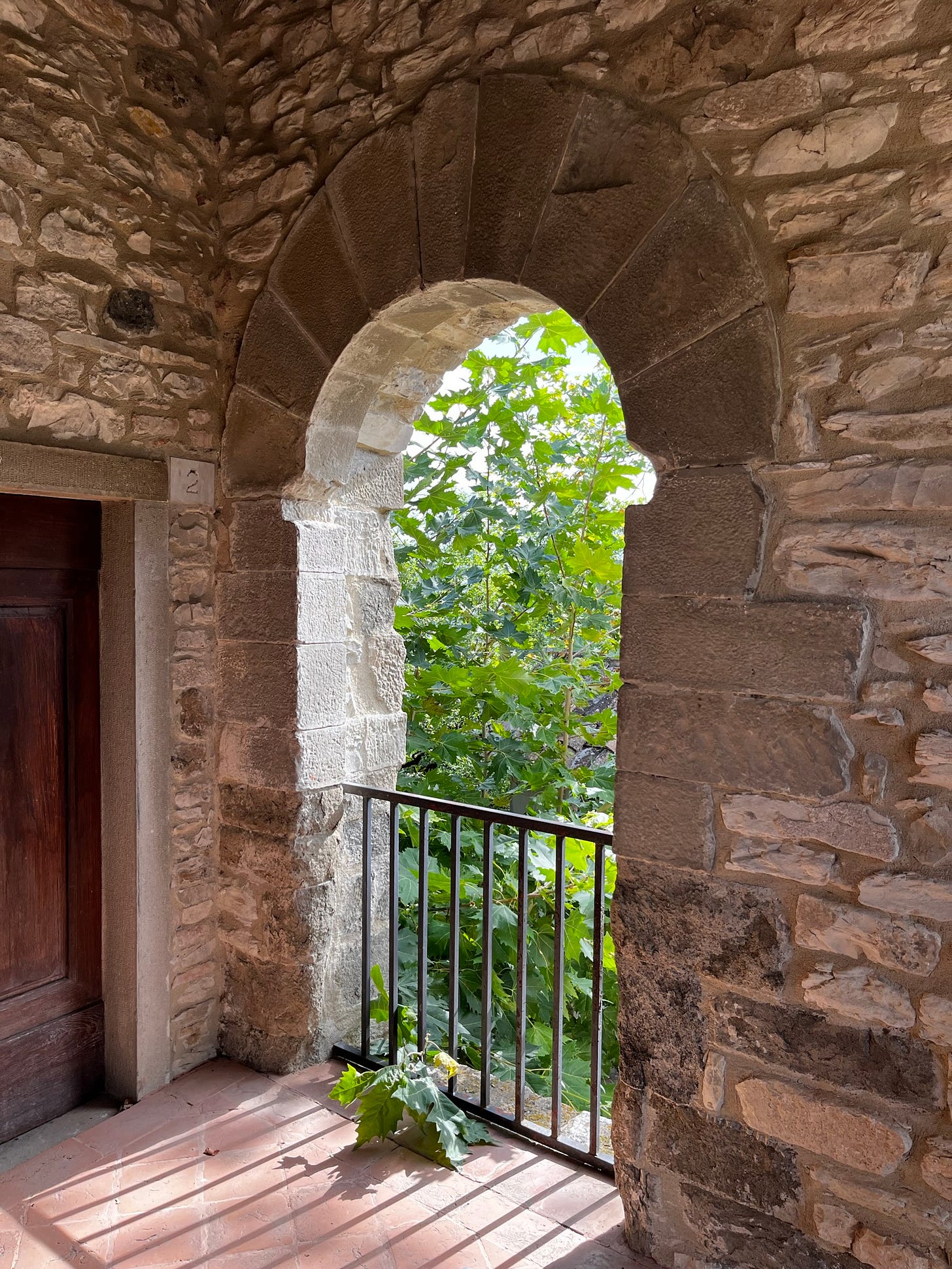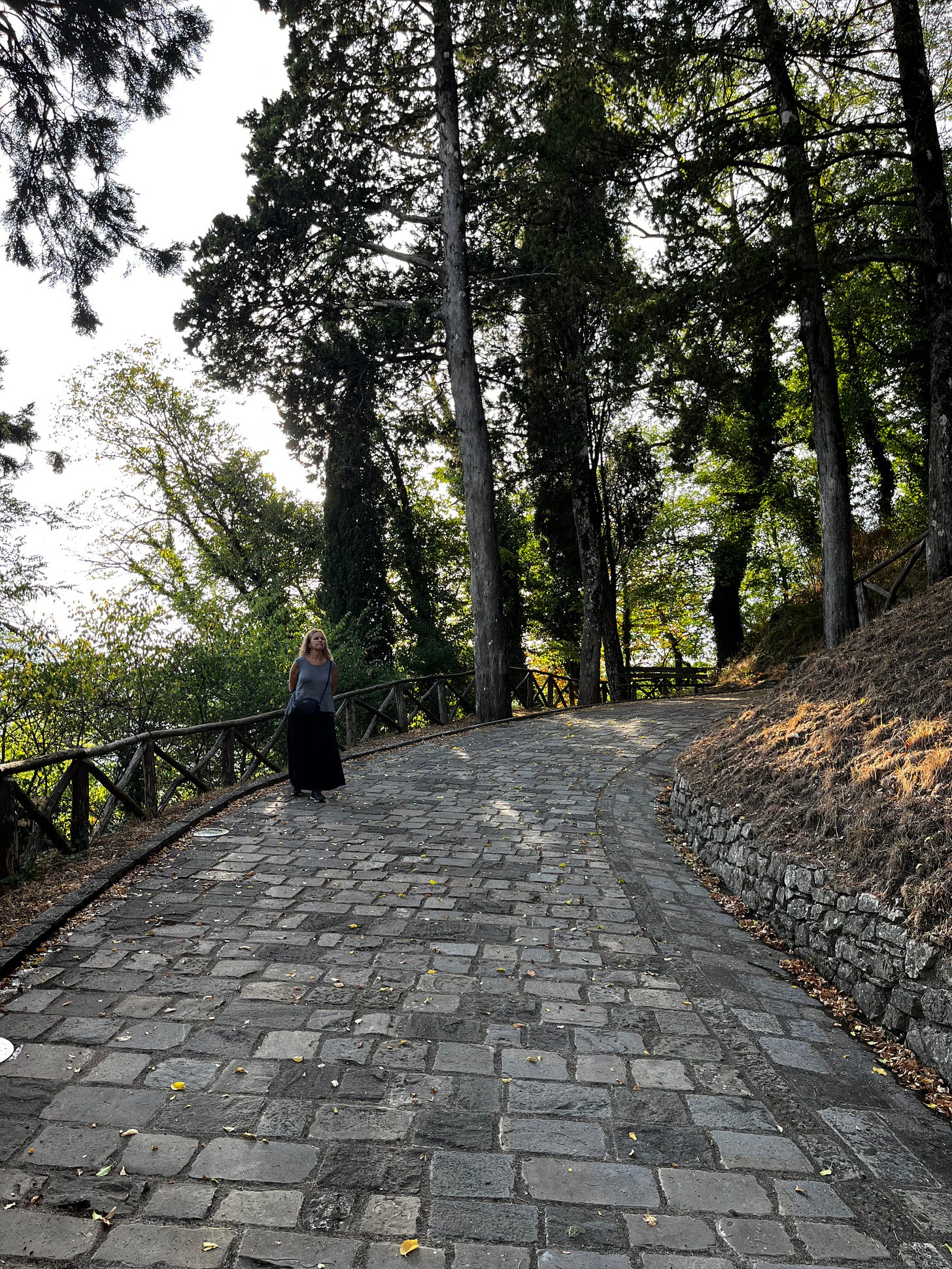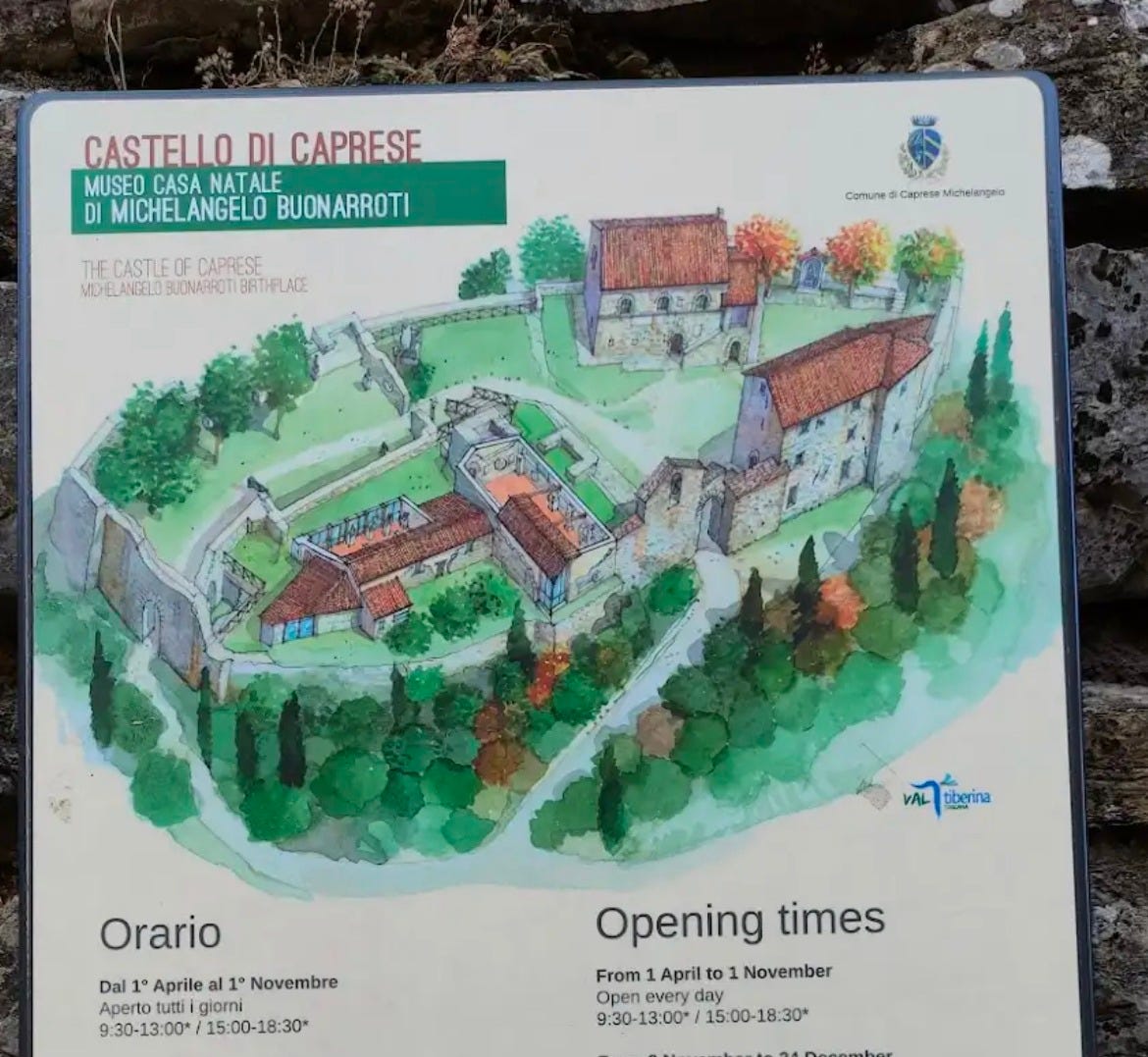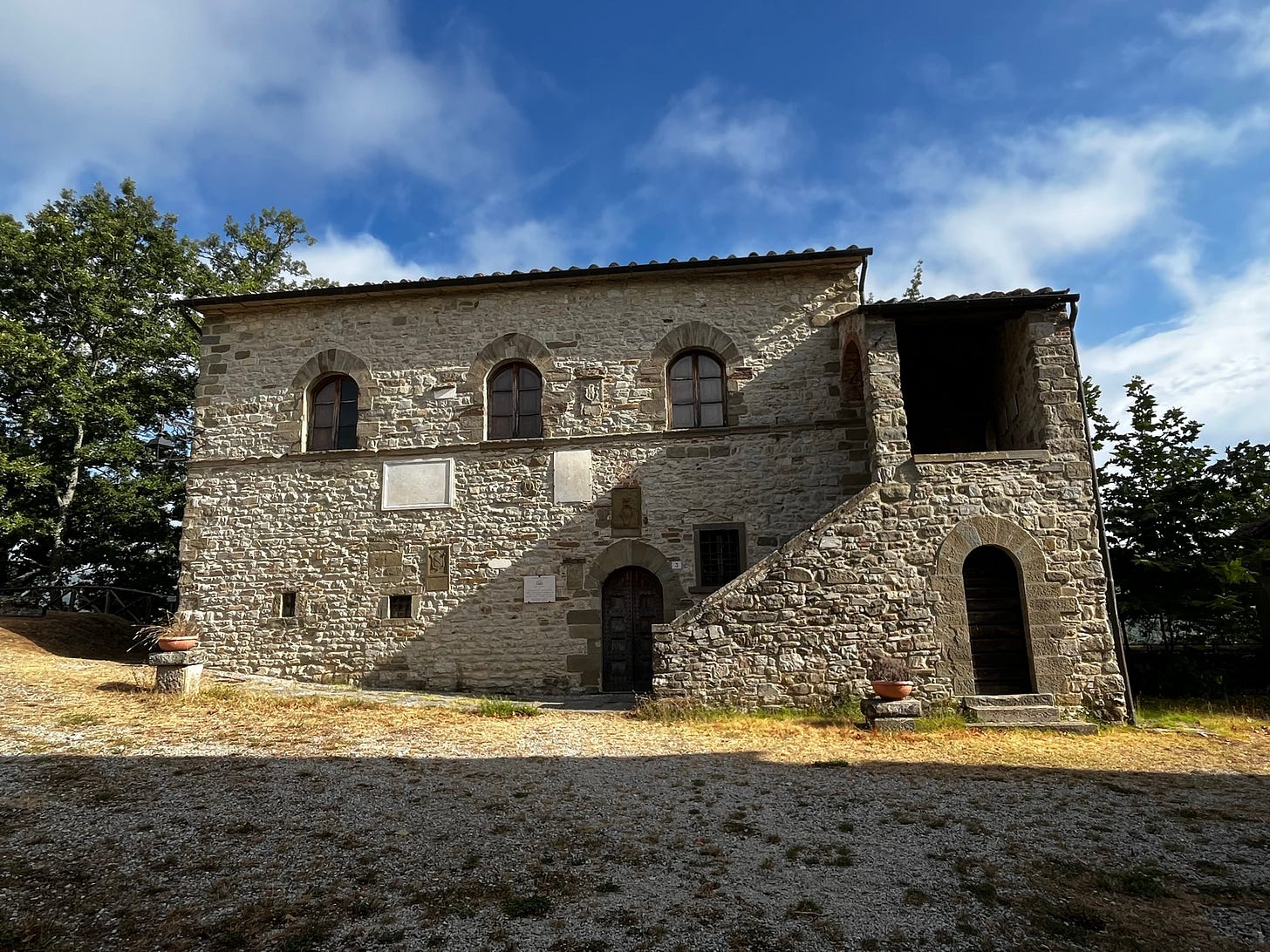A Journey to Michelangelo's Birthplace
Last August, in an effort to escape the summer heat, we planned a weekend getaway near the Parco Nazionale delle Foreste Casentesi, about 60 km southeast of Florence, nestled within the Tuscan Apennines. The mountains in this region reach altitudes of up to 1,600 meters and it offers a cool climate. In late afternoon, we visited the small town of Caprese, also known as Caprese Michelangelo, in honor of the great artist.
I’ve always been fascinated by the birthplaces of renowned figures, searching for clues that reveal the extraordinary potential of their origins. When I visit these places, there’s a part of me that expects to discover something special—something that makes me think, something like: “Of course! This place is worthy of a birthplace of a genius.” But at first glance, Caprese didn’t exude an obvious sense of greatness. It is a quiet village of about 1,300 people, nestled deep within the mountains, surrounded by nothing but nature. A winding cobblestone road led us to a small manor compound, its gate marking the birthplace of Michelangelo Buonarroti. Without the sign to confirm its significance, we might have passed by without a second thought.
It was only as we ventured further into the borgo that the importance of history began to settle in. To think that Michelangelo, one of the greatest minds of the Renaissance, was born here, in a simple place, in the middle of nowhere, was surreal.
We started our visit at the museum, displaying replicas of Michelangelo’s most famous works. We than made our way to the two-story stone house where he was born—a classic example of 15th-century Tuscan architecture.
Reflections from His Birthplace
Standing in the bedroom where Michelangelo was born on March 6, 1475, my mind wondered and imagined what it could have been like at that time. How did this place shape the early years of the boy who would one day paint the Sistine Chapel?
I moved toward the window, gazing at the same landscape the Buonarroti family once saw. For a moment, I let the weight of history settle in—this was the very place where he had spoken his first words, taken his first steps, and begun a journey that would leave an indelible mark on the world.
Being so close to something very real of “il Divino” (as he was called by his contemporaries) I became curious not just about who he was as an artist but as a person. I wanted to learn more about the individual behind the masterpieces.
My Search for Michelangelo the Man
Later that week, I delved into books and the internet, trying to find out more about his personal life. His mother, Francesca Neri, passed away when he was just six years old, a loss that deeply affected him. His father, Ludovico Buonarroti, a magistrate, initially hoped his son would follow in his footsteps and pursue a career in public service. However, Michelangelo had other aspirations. His education was unconventional, relying on hands-on experience, self-study, and mentorship from renowned artists. He further honed his craft through the study of classical sculptures and under the guidance of influential figures, most notably Lorenzo de’ Medici, who became a key patron in his early career.
But the most intriguing findings was his passion and love for poetry. Beyond being one of the greatest painters, sculptors, and architects of his time, Michelangelo was also a poet, he wrote over 300 poems. My curiosity brought me to read dozens of these poems and I thought I would share with you the ones that touched me the most because it made me understand more about Michelangelo the man. His writings revealed a melancholic side.
To shed light on this lesser-known aspect of his genius, I have selected a few poems from each of these four themes to share with you.
Let’s start with what he is better known for: Art
ON ART
Michelangelo was a perfectionist, and his poetry reflects his frustration, offering an intimate glimpse into his mastermind. His words reveal art as both a spiritual devotion and a lifelong struggle, as seen in the following excerpts from his sonnets.
The marble grows beneath my weary hand,
Yet in my heart, the form remains unclear.
My chisel strikes, but never as I planned—
For art is harsh, and beauty costs me dear.
➰➰
The burden of my labors weighs me down;
The hammer and the chisel are my chains.
Yet art alone gives meaning to my toil,
Though it consumes the body and the soul.
➰➰
Painting and sculpture will not let me rest;
A thousand labors press upon my soul.
But all I make is dust, and nothing whole,
For life is fleeting, and art brings no peace.
This poem, on the other hand, reflects the joy and fulfilment of creativity.
Blest be the hands that shape what hearts conceive,
For through our toil, the world is made anew.
From stone, a face; from paint, a living scene—
What greater gift than this for man to do?
ON PHILOSOPHY
Michelangelo often wrote about the conflict between earthly desires and the longing for spiritual transcendence. He saw the body as a temporary prison for the soul, yearning to reunite with the divine.
The following poems remind us that material achievements are fleeting and that true meaning comes from something greater.
What worth is there in riches, power, or fame?
A breath of wind, a shadow cast and gone.
We build, we fight, we dream—but in the end,
Only the heavens hold what we become.
➰➰
What need have I for gold, for pomp, for praise?
The earth is full, the sky is wide and bright.
A friend’s warm hand, the sun upon my face—
Are these not wealth, and joy, and life’s delight?
ON LOVE
There has been much discussion about Michelangelo’s personal relationships and the themes in his art. Many of his works prominently feature the male figure, and several of his poetic sonnets were dedicated to men, particularly the young Italian nobleman Tommaso Cavalieri, whom he met in his early twenties and remained friends with until his death.
Michelangelo’s appreciation for the male form was evident in his sculptures and paintings. His detailed depictions of male anatomy showcase both his artistic mastery and deep understanding of human musculature. His unique artistic style did not always conform strictly to the gender norms of his time. David is a prime example, reflecting his fascination with the male nude and the idealized human form.
He also had a very close friendship with Vittoria Colonna, the Marchioness of Pescara, which further adds to the complexity of his relationships. The two shared a deep intellectual and emotional bond, exchanging poetry and letters that conveyed a profound connection.
Michelangelo was an independent thinker who often challenged the conventions of his era. Given the societal context of his time, expressions of affection and deep companionship could take many forms. I have selected a few poems written to both Tommaso and Vittoria.
In the case of Vittoria, we can sense his admiration for her intelligence and religious devotion, portraying love as something divine and elevating rather than purely romantic.
Poems he wrote to Vittoria Colonna:
Beauty and virtue walk the same bright way,
And in your soul, they shine in equal grace.
Not earthly love, nor fleeting charm do stay—
But wisdom pure, and heaven’s own embrace.
➰➰
If a chaste love, if a lofty piety,
If a heart that knows no deceit or shame,
If a soul whose only aim is high,
If a mind that flees from fame.
➰➰
If these things can grant eternal life,
Then, O dear lady, with no fear or strife,
You shall ascend to the heavens above,
Crowned by virtue, faith, and love.
➰➰
But in your eyes, my lady bright,
I find a light that guides my sight,
A vision pure, divinely true,
A work of art shaped not by few.
Meanwhile, the poems dedicated to Tommaso reflect Michelangelo’s deep bond and love for him. It is important to remember that same-sex attraction was not accepted in Michelangelo’s era—those who engaged in it faced severe consequences, even the threat of being burned at the stake. Ultimately, we will never truly know Michelangelo’s sexuality. What stood out to me when reading these passages was not his orientation, but rather his intensity, sensitivity, and depth of emotion.
In the following poems, it is clear just how deeply he was captivated by Tommaso’s beauty. He describes feeling completely enchanted and emotionally bound, torn between the sweetness of love and the pain it brings. Despite being one of the greatest artists of all time, he admits that even his immense talent is not enough to fully capture the depth of his feelings.
With your fair eyes, a chain, a net, a snare,
You bind my soul and make me burn within.
No key, no art, can free me from despair—
Love holds me tight, yet I feel no sin.
➰➰
If through your beauty I have lost my way,
Let mercy’s hand lead me back to light.
For if my heart must suffer night and day,
Let love, not shame, command my sight.
➰➰
Why must I love, yet find no peace in love?
This love, this fire, a chain without release,
both gentle friend and most relentless foe—
it holds me close, yet lets my freedom go,
it offers joy, but gives no lasting peace.
➰➰
Love guides my brush and marble into life,
Yet no chisel can carve the fire I feel inside.
No artist’s hand can shape what my soul holds dear,
For beauty lives beyond what eyes can see.
ON MORTALITY
As Michelangelo aged, his poetry became more meditative, exploring themes of mortality, the afterlife, and his relationship with God.
These poems reveal his growing awareness of aging and his deep contemplation of death and what lies beyond. He does not see death as an end, but rather as a doorway to something greater, reflecting his hope for eternal peace.
Now hath my life across a stormy sea,
Like a frail bark, reached that wide port where all
Are bidden, ere the final reckoning fall
Of good and evil for eternity.
➰➰
My life’s journey has now reached, through a stormy sea,
A fragile boat in a harbor wide and still,
Where every deed of mine must now be weighed
Before the final reckoning of the soul.
➰➰
If love be true, then death is but a door,
And on the other side, a brighter sky.
So fear not, heart, for though this world may fade,
A greater world shall greet the open eye.
The Art, The Man, and My Discovery
Through his writings, I discovered a lesser-known side of Michelangelo—one that deepened my understanding of Il Divino and gave me an even greater appreciation for his art. His extensive travels, tireless work, and personal struggles did not seem to diminish his strength, as he lived an exceptionally long life for his time—88 years.
Despite his financial success, Michelangelo chose a simple and modest lifestyle. He rarely indulged in luxuries and was even described as somewhat frugal, preferring humility over extravagance. Yet, what remains undeniable is his courage, his defiance of conventions, and his unwavering dedication to his craft.
Today, when I stand before one of his masterpieces, I see more than just the marvel of his hands—I see a man of profound depth, resilience, and passion. His art is timeless, and his writings remind us that the struggles he faced are just as relevant today as they were 550 years ago.
Arrivederci until next Saturday—always observing, always sharing, always sipping, always a tale from an Italian coffee bar and beyond.













Tino…..je connaissais Michelangelo comme peintre, j’ai visité Florence mais votre article m’a fait découvrir l’homme sensible merci 🙏
Vous pourriez mettre un jour tous vos articles dans un livre…pourquoi pas 🧐
Your reverent writing properly evokes the holiness of your subject matter. Stunning article! I’ve never read anything so personal and empathic about Michelangelo. I felt awe as I knelt at his tomb in Florence, but capturing his earliest visions and influences is much more important. Thank you for this.